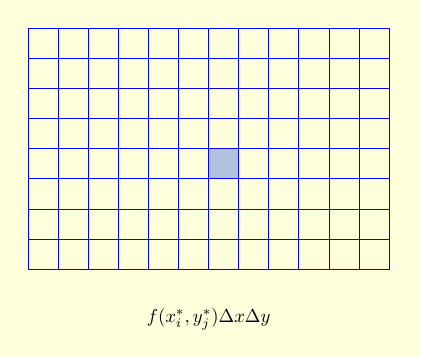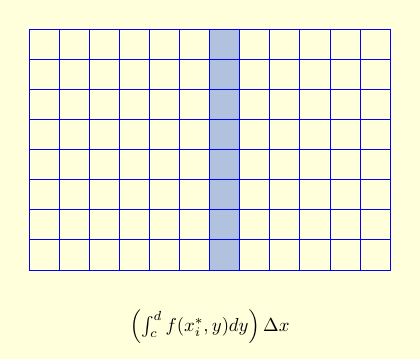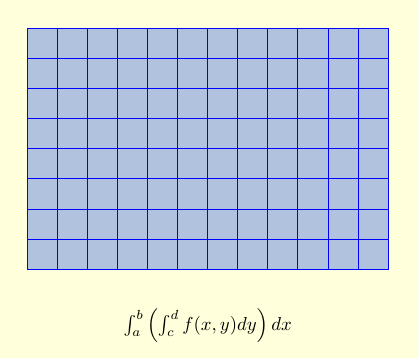
Home
The Fundamental Theorem of Calculus
Three Different QuantitiesThe Whole as Sum of Partial Changes
The Indefinite Integral as Antiderivative
The FTC and the Chain Rule
The Indefinite Integral and the Net Change
Indefinite Integrals and Anti-derivativesA Table of Common Anti-derivatives
The Net Change Theorem
The NCT and Public Policy
Substitution
Substitution for Indefinite IntegralsRevised Table of Integrals
Substitution for Definite Integrals
Area Between Curves
The Slice and Dice PrincipleTo Compute a Bulk Quantity
The Area Between Two Curves
Horizontal Slicing
Summary
Volumes
Slicing and Dicing SolidsSolids of Revolution 1: Disks
Solids of Revolution 2: Washers
Volumes Rotating About the $y$-axis
Integration by Parts
Behind IBPExamples
Going in Circles
Tricks of the Trade
Integrals of Trig Functions
Basic Trig FunctionsProduct of Sines and Cosines (1)
Product of Sines and Cosines (2)
Product of Secants and Tangents
Other Cases
Trig Substitutions
How it worksExamples
Completing the Square
Partial Fractions
IntroductionLinear Factors
Quadratic Factors
Improper Rational Functions and Long Division
Summary
Strategies of Integration
SubstitutionIntegration by Parts
Trig Integrals
Trig Substitutions
Partial Fractions
Improper Integrals
Type I IntegralsType II Integrals
Comparison Tests for Convergence
Differential Equations
IntroductionSeparable Equations
Mixing and Dilution
Models of Growth
Exponential Growth and DecayLogistic Growth
Infinite Sequences
Close is Good Enough (revisited)Examples
Limit Laws for Sequences
Monotonic Convergence
Infinite Series
IntroductionGeometric Series
Limit Laws for Series
Telescoping Sums and the FTC
Integral Test
Road MapThe Integral Test
When the Integral Diverges
When the Integral Converges
Comparison Tests
The Basic Comparison TestThe Limit Comparison Test
Convergence of Series with Negative Terms
IntroductionAlternating Series and the AS Test
Absolute Convergence
Rearrangements
The Ratio and Root Tests
The Ratio TestThe Root Test
Examples
Strategies for testing Series
List of Major Convergence TestsExamples
Power Series
Radius and Interval of ConvergenceFinding the Interval of Convergence
Other Power Series
Representing Functions as Power Series
Functions as Power SeriesDerivatives and Integrals of Power Series
Applications and Examples
Taylor and Maclaurin Series
The Formula for Taylor SeriesTaylor Series for Common Functions
Adding, Multiplying, and Dividing Power Series
Miscellaneous Useful Facts
Applications of Taylor Polynomials
What are Taylor Polynomials?How Accurate are Taylor Polynomials?
What can go Wrong?
Other Uses of Taylor Polynomials
Partial Derivatives
Definitions and RulesThe Geometry of Partial Derivatives
Higher Order Derivatives
Differentials and Taylor Expansions
Multiple Integrals
BackgroundWhat is a Double Integral?
Volumes as Double Integrals
Iterated Integrals over Rectangles
One Variable at the TimeFubini's Theorem
Notation and Order
Double Integrals over General Regions
Type I and Type II regionsExamples
Order of Integration
Area and Volume Revisited
One Variable at the Time
Now that we know what double integrals are, we can start to compute them. The key idea is: One variable at a time!
In order to integrate over a rectangle $[a,b] \times [c,d]$, we first integrate over one variable (say, $y$) for each fixed value of $x$. That's an ordinary integral, which we can do using the fundamental theorem of calculus. We then integrate the result over the other variable (in this case $x$), which we can also do using the fundamental theorem of calculus. So a 2-dimensional double integral boils down to two ordinary 1-dimensional integrals, one inside the other. We call this an iterated integral.
There are two ways to see the relation between double integrals and iterated integrals. In the bottom-up approach, we evaluate the sum $$\sum_{i=1}^m \sum_{j=1}^n f\left(x_{i}^*,y_{j}^*\right) \,\Delta x\, \Delta y,$$ by first summing over all of the boxes with a fixed $i$ to get the contribution of a column, and then adding up the columns. (Or we can sum over all of the boxes with a fixed $j$ to get the contribution of a row, and then add up the rows.)
| $f\left(x_{i}^*,y_{j}^*\right)\, \Delta y\, \Delta x$ is the approximate contribution of a single box to our double integral. |
|
| $\displaystyle\sum_{j=1}^n f\left(x_{i}^*,y_{j}^*\right) \,\Delta y\, \Delta x$ is the approximate contribution of all the boxes in a single column. As $n \to \infty$, the sum over $n$ turns into an integral, and we get $$\displaystyle\left (\int_c^d f\left(x_i^*, y\right)\,dy \right )\, \Delta x.$$ |
|
| Adding up the columns then gives $\displaystyle\sum_{i=1}^m \left (\int_c^d f\left(x_i^*, y\right)\, dy \right )\, \Delta x$. Taking a limit as $m \to \infty$ turns the sum into an iterated integral: $$\int_a^b \left ( \int_c^d f(x,y)\, dy \right ) \,dx.$$ |
|
This bottom-up approach is explained in the following video. (Video Fix? However, there is a small error. At the beginning it says that we're going to integrate over the rectangle $[0,1] \times [0,2]$, but for the rest of the video the region $R$ is actually the rectangle $[0,2] \times [0,1]$.)
Cavalieri's Principle
An alternate approach to finding volumes (and hence double integrals)
- the so-called Slice Method - was formulated by
Cavalieri
and is expressed mathematically in
Cavalieri's Principle: let $W$ be a solid and $P_x,\, a \le x \le b,$ be a family of parallel planes such that
|
We already used this idea to compute volumes of revolution. Suppose $W$ is created by rotating the graph of $y = f(x),\, a \le x \le b,$ about the $x$-axis. When $P_x$ is a plane perpendicular to the $x$-axis, then the slice of $W$ cut by $P_x$ is a disk of radius $f(x)$. Here $A(x) = \pi f(x)^2$, so we recover the familiar result $$\hbox{ volume of} \ W \ = \ \pi \int_a^b\, f(x)^2\, dx$$ for a volume of revolution. But Cavalieri's Principle does not require the cross-sections to be triangles or disks!
|
Example: Find the volume of the solid $W$ under the
hyperbolic paraboloid
$$z \ = \ f(x,\, y) \ = \ 2+ x^2 - y^2 $$
and over the square $D\,= \,[-1,\,1]\,\times\,[-1,\,1]$.
Solution: The solid is shown below. When $P_x$ is the vertical slice perpendicular to the $x$-axis for fixed $x$ shown in purple, then $$A(x) =\int_{-1}^2\, (2+x^2 - y^2)\, dy\qquad \qquad$$ $$\qquad = \left[\,2y +x^2y -\frac{y^3}{3}\right]_{-1}^1= \frac{10}{3} +2x^2 \,.$$ But then by using the slider to fill out the solid, Cavalieri's Principle shows that $W$ has $$\hbox{volume} \ = \ \int_{-1}^1\, A(x)\, dx \ = \ \int_{-1}^1\, \left(\frac{10}{3} +2x^2\right)\,dx \ = \ \left[\frac{10x}{3} +\frac{2x^3}{3}\right]_{-1}^1 \ = \ 8\,.$$ |
In other words, the volume of a region is $\int_a^b A(x)\, dx$, where $A(x)$ is the cross-sectional area at a particular value of $x$. But that's the area under the curve $z=f(x,y)$, where we are treating $x$ as a constant and $y$ as our variable. That is,
| The double integral $\displaystyle\iint_R f(x,y)\, dA$ equals the iterated integral $\displaystyle\int_a^b \left (\int_c^d f(x,y) \,dy\right )\, dx$. |


